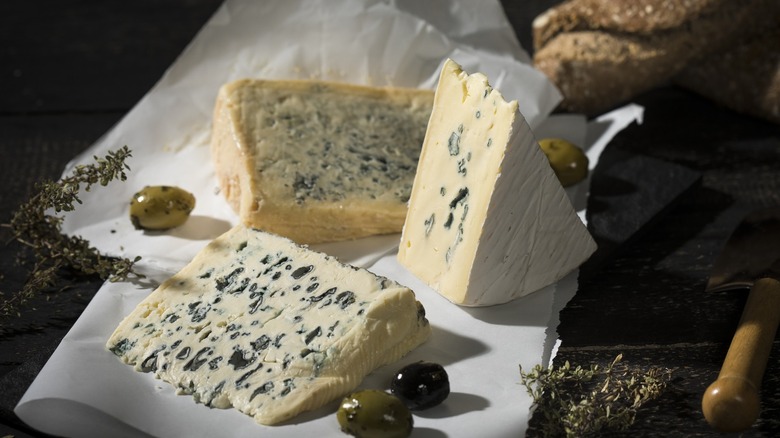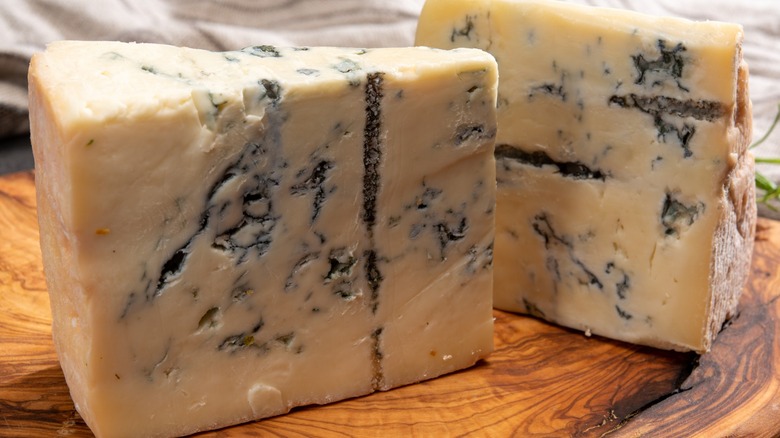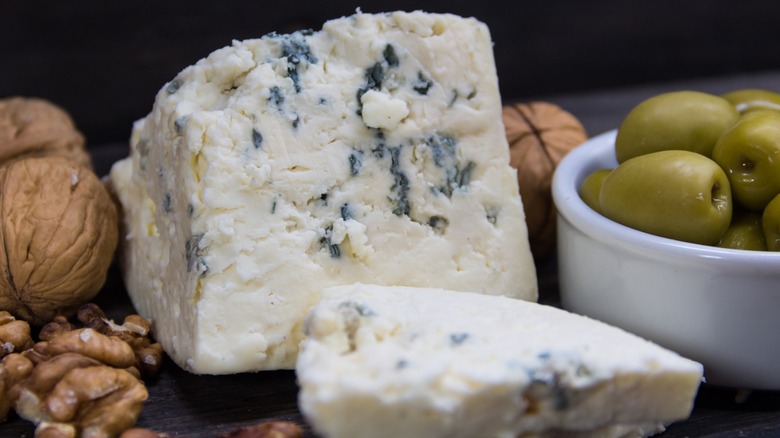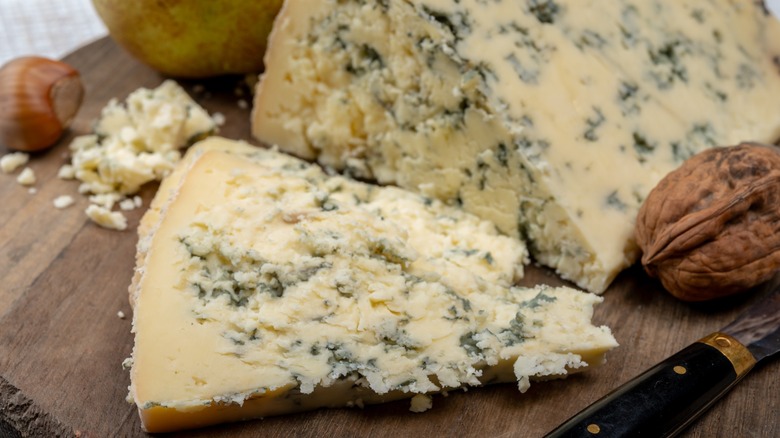Gorgonzola Vs Roquefort Vs Stilton Blue Cheese: What's The Difference?
Blue cheese is one of those polarizing creations that either earns applause or leaves people appalled. It's undeniably an acquired taste. For enthusiasts, it's that bold, pungent, and slightly piquant bite that elevates a simple dish like a savory mashed potato. But for others, the sight of its blue-green streaks is even enough to scare them away, let alone the intense flavor. Made from pasteurized cow, sheep, or goat milk, blue cheese gets its distinct flavor and appearance from the introduction of Penicillium mold during the cheese-making process. As it ages, the cheese is pierced with stainless steel needles or rods that allows oxygen to penetrate and stimulate mold growth, which forms its signature blue veins. While its "moldy" appearance might suggest an everlasting shelf, blue cheese can actually go bad without proper storage.
Though often associated with European roots, blue cheese has a century-old history in the U.S., with Wisconsin at the forefront of producing top-quality varieties. However, the most renowned blue cheeses still come from Europe. Among the many types, three remain the most celebrated: Gorgonzola, Roquefort, and Stilton. Despite their shared characteristic of blue marbling, each of these cheeses offers distinct differences in origin, dairy type, and taste, together highlighting the diversity within this unique, complex cheese category.
Gorgonzola
One of the oldest blue cheeses in the world, Gorgonzola originated in Italy and is widely produced in the Lombardy and Piedmont regions. Its invention is believed to be tied to a love story dating back to 879 A.D. in Lombardy. According to legend, a young man, enamored with a woman, left cheese curds in a cave overnight while pursuing her. The next day, he hastily mixed the forgotten curds with fresh ones to hide his mistake. Weeks later, blue veins appeared in the cheese, and its taste was extraordinary–marking the accidental creation of Gorgonzola.
Today, in order to be called Gorgonzola, it must be awarded the PDO (Protected Designation of Origin). Made primarily from pasteurized milk of Piedmontese cattle, Gorgonzola boasts a creamy texture and subtle sweetness that distinguishes it from the slightly crumbly Stilton and the more pungent Roquefort. Gorgonzola comes in two varieties: Gorgonzola Dolce, which is sweeter and creamier, and Gorgonzola Piccante, known for its firmer, crumblier texture. Incredibly versatile, Gorgonzola complements both savory and sweet dishes, and it pairs great with fruits like pears and figs on charcuterie boards, and also enhances a range of dishes, from simple salads to delicious pastas. For example, pear and Gorgonzola ravioli is a perfect culinary match that offers a heavenly combination of flavors.
Roquefort
As one of the most renowned ancient cheeses originating from France, Roquefort is a PDO (Protected Designation of Origin) cheese that was developed around the same time as Gorgonzola. Similar to the love story of Gorgonzola, legend says that Roquefort was born when a distracted shepherd left his cheese in a cave, only to return days later to find it transformed by blue-green mold. Whether legend or reality, Roquefort's authenticity and unique flavor are guaranteed by law, and it is required to be aged in the limestone caves of Combalou mountain in Roquefort-sur-Soulzon.
Unlike Gorgonzola, Roquefort is made from pasteurized sheep's milk and is traditionally wrapped in foil marked with a red sheep symbol. Its aroma and taste are the strongest among the three classic blue cheeses. Roquefort comes in four main varieties: Papillon, Société, Carles, and Vernières with each offering subtle differences in flavor. Known for its sharp, robust, and salty taste, Roquefort delivers layers of herbaceous, earthy, and nutty complexity, thanks to the richness of the sheep's milk. Like Gorgonzola, it has a creamy texture interspersed with crumbly bits.
Roquefort shines when paired with a range of flavors, from the sweetness of apricots and dates to the crunch of toasted nuts and fresh vegetables. Its deep earthiness makes it a natural companion for mushrooms, especially in dishes like Roquefort and mushroom fondue, where the cheese melts into a creamy blend packed with umami-ness.
Stilton blue cheese
Praised by Anthony Bourdain as the "king of cheeses," Stilton is a well-known PDO blue cheese from England, made from pasteurized cow's milk. Relatively a younger blue cheese variety compared to Gorgonzola and Roquefort, Stilton is believed to have been created in the 18th century, it is now produced in Derbyshire, Nottinghamshire, or Leicestershire in the UK.
Stilton, while still creamy, is slightly firmer than Gorgonzola and Roquefort, with a semi-soft and moist texture. It's less pungent and salty than the intense Roquefort, making it more versatile. Stilton pairs beautifully with sweetness–try it with a drizzle of honey, alongside dried fruits and nuts, or a glass of port wine, which perfectly balances its saltiness.
The slightly fruity, savory flavor of Stilton also makes it an excellent companion to whisky, especially Rye. If you're in the mood for something bold and toasty, kick your next rarebit up a notch with some punchy Stilton and sweet onion jam. It's a flavor-packed combo that'll turn this classic dish into a real showstopper!



